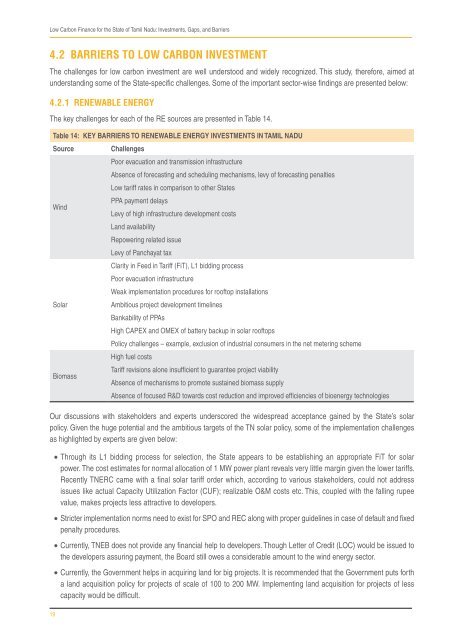Low-Carbon-Finance-for-the-State-of-Tamil-Nadu-Investments-Gaps-and-Barriers - Shakti Foundation
You also want an ePaper? Increase the reach of your titles
YUMPU automatically turns print PDFs into web optimized ePapers that Google loves.
<strong>Low</strong> <strong>Carbon</strong> <strong>Finance</strong> <strong>for</strong> <strong>the</strong> <strong>State</strong> <strong>of</strong> <strong>Tamil</strong> <strong>Nadu</strong>: <strong>Investments</strong>, <strong>Gaps</strong>, <strong>and</strong> <strong>Barriers</strong><br />
4.2 BARRIERS TO LOW CARBON INVESTMENT<br />
The challenges <strong>for</strong> low carbon investment are well understood <strong>and</strong> widely recognized. This study, <strong>the</strong>re<strong>for</strong>e, aimed at<br />
underst<strong>and</strong>ing some <strong>of</strong> <strong>the</strong> <strong>State</strong>-specific challenges. Some <strong>of</strong> <strong>the</strong> important sector-wise findings are presented below:<br />
4.2.1 RENEWABLE ENERGY<br />
The key challenges <strong>for</strong> each <strong>of</strong> <strong>the</strong> RE sources are presented in Table 14.<br />
Table 14: Key <strong>Barriers</strong> to renewable energy <strong>Investments</strong> in TAMIL NADU<br />
Source<br />
Challenges<br />
Poor evacuation <strong>and</strong> transmission infrastructure<br />
Absence <strong>of</strong> <strong>for</strong>ecasting <strong>and</strong> scheduling mechanisms, levy <strong>of</strong> <strong>for</strong>ecasting penalties<br />
<strong>Low</strong> tariff rates in comparison to o<strong>the</strong>r <strong>State</strong>s<br />
PPA payment delays<br />
Wind<br />
Levy <strong>of</strong> high infrastructure development costs<br />
L<strong>and</strong> availability<br />
Repowering related issue<br />
Levy <strong>of</strong> Panchayat tax<br />
Clarity in Feed in Tariff (FiT), L1 bidding process<br />
Poor evacuation infrastructure<br />
Weak implementation procedures <strong>for</strong> ro<strong>of</strong>top installations<br />
Solar<br />
Ambitious project development timelines<br />
Bankability <strong>of</strong> PPAs<br />
High CAPEX <strong>and</strong> OMEX <strong>of</strong> battery backup in solar ro<strong>of</strong>tops<br />
Policy challenges – example, exclusion <strong>of</strong> industrial consumers in <strong>the</strong> net metering scheme<br />
High fuel costs<br />
Tariff revisions alone insufficient to guarantee project viability<br />
Biomass<br />
Absence <strong>of</strong> mechanisms to promote sustained biomass supply<br />
Absence <strong>of</strong> focused R&D towards cost reduction <strong>and</strong> improved efficiencies <strong>of</strong> bioenergy technologies<br />
Our discussions with stakeholders <strong>and</strong> experts underscored <strong>the</strong> widespread acceptance gained by <strong>the</strong> <strong>State</strong>’s solar<br />
policy. Given <strong>the</strong> huge potential <strong>and</strong> <strong>the</strong> ambitious targets <strong>of</strong> <strong>the</strong> TN solar policy, some <strong>of</strong> <strong>the</strong> implementation challenges<br />
as highlighted by experts are given below:<br />
• Through its L1 bidding process <strong>for</strong> selection, <strong>the</strong> <strong>State</strong> appears to be establishing an appropriate FiT <strong>for</strong> solar<br />
power. The cost estimates <strong>for</strong> normal allocation <strong>of</strong> 1 MW power plant reveals very little margin given <strong>the</strong> lower tariffs.<br />
Recently TNERC came with a final solar tariff order which, according to various stakeholders, could not address<br />
issues like actual Capacity Utilization Factor (CUF); realizable O&M costs etc. This, coupled with <strong>the</strong> falling rupee<br />
value, makes projects less attractive to developers.<br />
• Stricter implementation norms need to exist <strong>for</strong> SPO <strong>and</strong> REC along with proper guidelines in case <strong>of</strong> default <strong>and</strong> fixed<br />
penalty procedures.<br />
• Currently, TNEB does not provide any financial help to developers. Though Letter <strong>of</strong> Credit (LOC) would be issued to<br />
<strong>the</strong> developers assuring payment, <strong>the</strong> Board still owes a considerable amount to <strong>the</strong> wind energy sector.<br />
• Currently, <strong>the</strong> Government helps in acquiring l<strong>and</strong> <strong>for</strong> big projects. It is recommended that <strong>the</strong> Government puts <strong>for</strong>th<br />
a l<strong>and</strong> acquisition policy <strong>for</strong> projects <strong>of</strong> scale <strong>of</strong> 100 to 200 MW. Implementing l<strong>and</strong> acquisition <strong>for</strong> projects <strong>of</strong> less<br />
capacity would be difficult.<br />
19

















